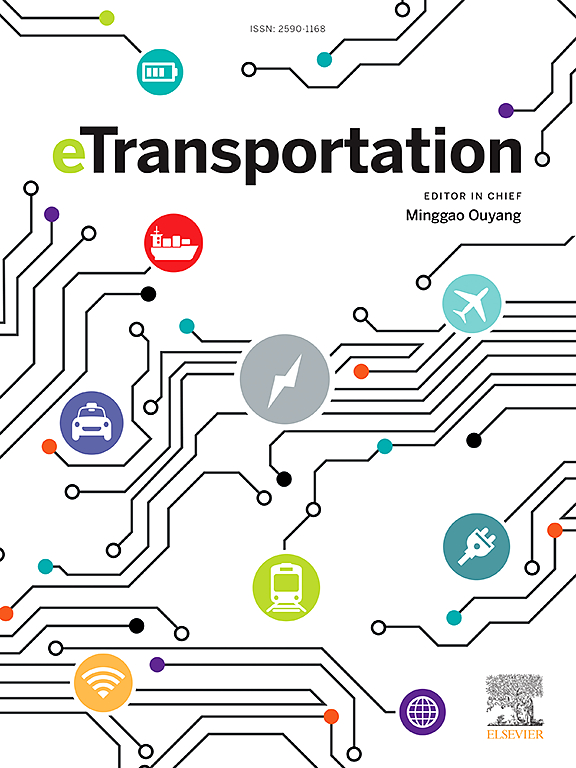住宅用户和重型车辆双向收费的商业案例
IF 17
1区 工程技术
Q1 ENERGY & FUELS
引用次数: 0
摘要
在推动交通运输部门脱碳的过程中,整合电动汽车(ev)至关重要。“车到一切”服务可以解决电动汽车接受度和电网整合的问题,但可行的商业模式是激励用户参与的必要条件。本文提出了一种技术经济混合整数线性规划优化模型,以评估住宅用户和重型车队双向收费的可行性。该模型确保了适当的电池退化管理,并在充电地点集成了可再生能源。价格套利(PA),特别是车辆到家庭(V2H)和住宅车辆到电网(V2G),探讨了RUs。对于大型电动汽车车队,研究了V2G PA和V2G结合频率控制储备(FCR-D)。商业案例指导优化,模拟了丹麦东部一年的运营。结果与没有双向充电能力的基线情况进行了比较。根据充电设备供应商的不同,RUs平均节省成本176欧元,投资回收期为5至23年。V2H被证明最适合具有灵活收费模式的远程用户。虽然单独使用V2G并不能显著节省电动汽车车队的成本,但V2G与FCR-D相结合可节省33万欧元,投资回收期为3至17年。由于商用双向充电设备的稀缺性和驾驶模式数据的有限性,挑战仍然存在。然而,我们的分析表明,双向充电为RUs和车队管理人员提供了大量的经济激励,促进了电动汽车的采用,并推进了运输部门的脱碳。本文章由计算机程序翻译,如有差异,请以英文原文为准。
Business cases for degradation-aware bidirectional charging of residential users and heavy-duty vehicle fleets
In the push towards decarbonizing the transport sector, integrating electric vehicles (EVs) is crucial. Vehicle-to-everything services can address concerns about EV acceptance and grid integration, but viable business models are necessary to incentivize user participation. This paper presents a techno-economic mixed integer linear programming optimization model to assess the feasibility of bidirectional charging for residential users (RUs) and heavy-duty fleet vehicles. The model ensures proper battery degradation management and integrates renewable energy sources at charging locations. Price arbitrage (PA), specifically vehicle-to-home (V2H) and residential vehicle-to-grid (V2G), is explored for RUs. For larger EV fleets, V2G PA and V2G combined with frequency containment reserve for disturbances (FCR-D) are investigated. Business cases guide the optimization, simulating a year of operation in Eastern Denmark. The results are compared to a baseline scenario with no bidirectional charging capability. RUs achieve average cost savings of 176 € with a payback period of 5 to 23 years, depending on the charging equipment supplier. V2H proves most suitable for remote users with flexible charging patterns. While EV fleets do not see significant savings with V2G alone, V2G combined with FCR-D yields savings of 330 thousand € with a payback period of 3 to 17 years. Challenges remain due to the rarity of commercially available bidirectional charging equipment and limited data on driving patterns. However, our analysis shows that bidirectional charging offers substantial financial incentives for both RUs and fleet managers, promoting EV adoption and advancing transport sector decarbonization.
求助全文
通过发布文献求助,成功后即可免费获取论文全文。
去求助
来源期刊

Etransportation
Engineering-Automotive Engineering
CiteScore
19.80
自引率
12.60%
发文量
57
审稿时长
39 days
期刊介绍:
eTransportation is a scholarly journal that aims to advance knowledge in the field of electric transportation. It focuses on all modes of transportation that utilize electricity as their primary source of energy, including electric vehicles, trains, ships, and aircraft. The journal covers all stages of research, development, and testing of new technologies, systems, and devices related to electrical transportation.
The journal welcomes the use of simulation and analysis tools at the system, transport, or device level. Its primary emphasis is on the study of the electrical and electronic aspects of transportation systems. However, it also considers research on mechanical parts or subsystems of vehicles if there is a clear interaction with electrical or electronic equipment.
Please note that this journal excludes other aspects such as sociological, political, regulatory, or environmental factors from its scope.
 求助内容:
求助内容: 应助结果提醒方式:
应助结果提醒方式:


